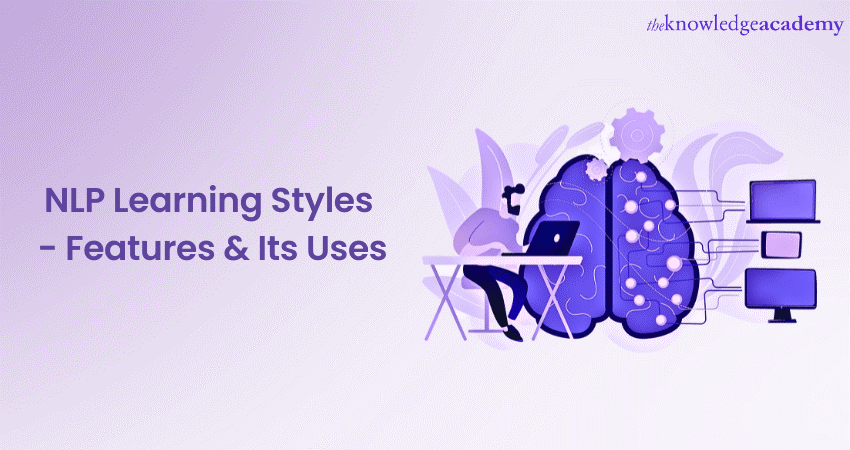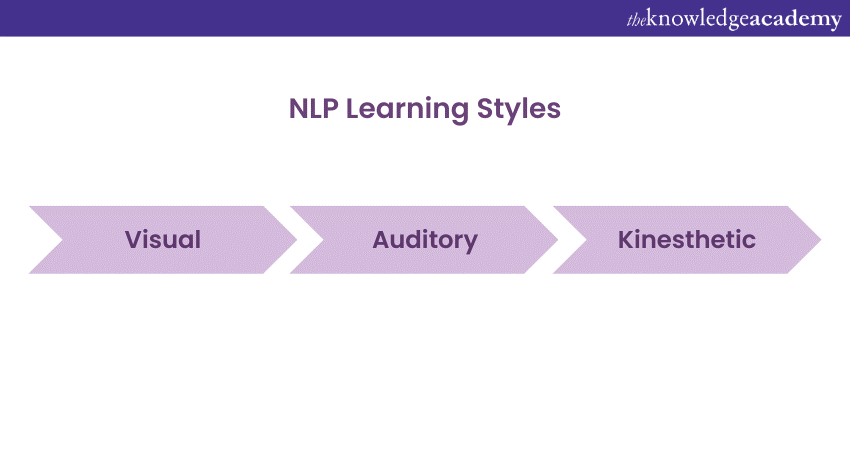We may not have the course you’re looking for. If you enquire or give us a call on +41 315281584 and speak to our training experts, we may still be able to help with your training requirements.
Training Outcomes Within Your Budget!
We ensure quality, budget-alignment, and timely delivery by our expert instructors.

Neuro-Linguistic Programming (NLP) is a widely used approach that showcases the relationship between the mind, language, and behaviour and helps individuals grow to unlock their full potential. NLP acknowledges that people have different ways of perceiving and retaining information, resulting in forming the different NLP Learning Styles.
Recognising and understanding these styles is crucial, as it allows educators and learners to tailor their approaches accordingly. Individuals can maximise their learning potential by employing NLP techniques that align with specific studying styles.
In this blog, we will explore the various learning styles of NLP and steps to identify your own style to improve your NLP skills.
Table of Contents
1) Why are individual learning styles important?
2) Learning styles by NLP
a) Visual
b) Auditory
c) Kinaesthetic
3) Conclusion
Why are individual learning styles important?
Acknowledging individual styles of learning is crucial in NLP because tailoring teaching methods and materials according to individuals’ preferences can significantly enhance the studying experience. Moreover, individuals can foster collaboration and mutual understanding by embracing the diversity of study styles. Recognising that others may have different modalities can lead to more empathetic communication and improved relationships.
The Visual, Auditory, and Kinaesthetic or VAK model is a widely recognised framework for understanding the learning styles of NLP. It categorises individuals into three primary modalities, which are:
a) Visual
b) Auditory
c) Kinaesthetic
Learning styles by NLP

The three main studying styles utilised by NLP are visual, auditory, and kinaesthetic. The features and characteristics of them are as follows:
Visual
Visual learners rely heavily on visual cues and stimuli to understand and retain information. Understanding the features of visual learners allows educators to employ teaching strategies that cater to their strengths. Here are some of the features and characteristics of visual learners:
a) Strong visual processing: Visual learners have a heightened ability to process and retain information presented in visual formats. They excel in understanding concepts through visual aids such as graphs, charts, diagrams, and illustrations and have a keen eye for detail.
b) Visualising: Visual learners are naturally inclined to visualise and imagine scenarios in their mind's eye. This ability to mentally "see" information allows visual learners to grasp abstract ideas and make connections between different pieces of information efficiently.
c) Organisational and spatial skills: Visual learners often possess strong organisational and spatial skills. They can easily create mental maps, organise information hierarchically, and understand spatial relationships between objects or ideas.
d) Preference for written material: They prefer written materials, as they can visually scan, highlight, and annotate text to aid comprehension. They may benefit from taking detailed notes, using colour-coded systems, and creating visual summaries or flashcards to reinforce their learning.
Auditory
Auditory learners excel in processing information through sound and verbal communication. Teachers can tailor their teaching methods according to the preferences of auditory learners. Here are some of the features and characteristics of auditory learners:
a) Acute listening skills: Auditory learners have a heightened ability to focus and process information through sound. They excel at listening attentively to verbal instructions, lectures, discussions, and audio materials.
b) Memorisation through repetition: Auditory learners have a natural ability to memorise information through auditory cues, such as reciting facts aloud or using mnemonic techniques that involve verbal repetition.
c) Enhanced language skills: They often excel in language-based subjects such as literature and poetry, have an expanded vocabulary, and can grasp complex sentence structures and verbal cues with ease.
d) Preference for verbal communication: Auditory learners respond well to verbal instructions and explanations. They appreciate clear and concise verbal guidance, as it helps them understand and process information more readily.
Kinaesthetic
Kinaesthetic learners are experiential and learn best through physical engagement and hands-on activities. Providing opportunities for hands-on activities, incorporating movement, and using physical materials can enhance kinaesthetic learners' engagement and learning outcomes. Here are some of the features and characteristics of kinaesthetic learners:
a) Hands-on approach: Kinaesthetic learners have a preference for hands-on activities in the studying process, as they learn best through direct experiences, tactile sensations, and movement.
b) Spatial awareness and body language: They have a heightened spatial awareness and a keen sense of their body in space. They often use gestures, body language, and physical cues to understand and express themselves.
c) Need for physical materials: Kinaesthetic learners thrive when provided with manipulatives and physical materials. These can include objects, models, puzzles, or interactive study tools.
d) Multi-sensory studying: They often benefit from a multi-sensory approach to studying. They engage with multiple senses simultaneously, combining touch, movement, and sometimes auditory or visual stimuli.
Take the first step in mastering Neuro-Linguistic Programming with our NLP Training courses now!
How to identify your own learning style?
Recognising your learning style is the first step to promoting self-awareness and taking ownership of your education. When individuals understand how they learn best, they can advocate for their preferred studying strategies, seek resources and materials that align with their style, and actively engage in the studying process. Here are two simple steps that you can follow to discover your studying style:
a) Reflect on past experiences: The first step to discovering your style involves tracing back your memories to identify the methods you’ve used previously. You must try to recollect if you respond better to visual, auditory, or kinaesthetic cues. This is an effective way that can provide insights into your learning preference.
b) Observe your study habits: The second step is to pay attention to your approach to studying. Do you prefer taking detailed notes? Do you find explaining concepts to others or engaging in discussions helpful? Do you benefit from visual aids, creating diagrams, or using physical materials? Understanding the techniques and strategies you naturally gravitate towards can give you clues about your learning style.
Transform your career by mastering Neuro-linguistic programming. Sign up for our Master Diploma In NLP course now!
Conclusion
NLP Learning Styles offer valuable insights into how individuals perceive information. By harnessing these styles, educators and learners can optimise the studying process. We hope this blog has helped you explore the features and characteristics of visual, auditory, and kinaesthetic learners and learn about the methods to identify your learning style.
Improve your understanding of the practical applications of NLP with our NLP Foundation And Practitioner Training course now!
Frequently Asked Questions
Upcoming Business Skills Resources Batches & Dates
Date
 Neuro Linguistic Programming
Neuro Linguistic Programming
Fri 17th Jan 2025
Fri 21st Mar 2025
Fri 16th May 2025
Fri 18th Jul 2025
Fri 19th Sep 2025
Fri 21st Nov 2025







 Top Rated Course
Top Rated Course



 If you wish to make any changes to your course, please
If you wish to make any changes to your course, please


